An Overview of Use of Linz-Donawitz (LD) Steel Slag in Agriculture
Sasmita Chand 1 * , Biswajit Paul1 and Manish Kumar2
1
Department of Environmental Science and Engineering,
Indian School of Mines,
Dhanbad,
India
2
Department of Environment and Sustainability,
CSIR- Institute of Minerals and Materials Technology-IMMT,
Bhubaneswar,
India
Corresponding author Email: chand.sasmita@yahoo.in
DOI: http://dx.doi.org/10.12944/CWE.10.3.29
Slag generated from basic oxygen furnace (BOF) or Linz-Donawitz (LD) converter is one of the recyclable wastes in integrated steel plants. This paper deals with the present and possible use of LD slag in agriculture. At present, the amount of slag deposited in storage yard, leading to the occupation of farm land and serious pollution to the environment. Improving the slag utilization is an important way to resolve these problems. The physical and chemical characteristics of steel slag were analyzed and then the research progress of steel slag utilization in agriculture as fertilizer introduced. Due to increasing awareness of the environment, disposal, reuse of wastes without harming the environment has became a prime concern for the industry. The local availability of non conventional sources of plant nutrients and soil conditioners plays a vital role because of the non availability and higher price of environmental fertilizers. Therefore, this waste can be utilized for enhancing yield as well as solving the disposal problem and improve the environment.
Copy the following to cite this article:
Chand S, Paul B, Kumar M. An Overview of Use of Linz-Donawitz (LD) Steel Slag in Agriculture. Curr World Environ 2015;10(3) DOI:http://dx.doi.org/10.12944/CWE.10.3.29
Copy the following to cite this URL:
Chand S, Paul B, Kumar M. An Overview of Use of Linz-Donawitz (LD) Steel Slag in Agriculture. Available from: http://www.cwejournal.org/?p=13052
Download article (pdf)
Citation Manager
Publish History
Select type of program for download
| Endnote EndNote format (Mac & Win) | |
| Reference Manager Ris format (Win only) | |
| Procite Ris format (Win only) | |
| Medlars Format | |
| RefWorks Format RefWorks format (Mac & Win) | |
| BibTex Format BibTex format (Mac & Win) |
Article Publishing History
| Received: | 2015-09-13 |
|---|---|
| Accepted: | 2015-11-04 |
Introduction
Steel plant slag is a solid industrial waste generated from steel industries in production of steel and mainly these wastes includes blast furnace and steel melting slag (open hearth or LD process slag). It can be categorized as carbon steel slag and stainless steel slag according to the type of steel, and as pretreatment slag, Linz-Donawitz (LD) converter slag, electrical arc furnace slag (EAFS), ladle refining slag and casting residue according to the steelmaking process (Meng and Liu, 2000). Basically, LD slag is generated from steel making process or pig iron refining process in oxygen converters, this process is Linz- Donawitz process (Das et al., 2007; Alexandre et al., 1993; Wu et al., 2007; Shen et al., 2009). LD converter steel making slag is one of the important wastes in all integrated steel plant. The total generation rate of LD slag is 150-180kg/t of crude steel in India (Yadav et al., 2002). The generation per annum is 1.28 MT in SAIL (Basu, 2002) and worldwide generation is about 47 MT per annum (Takano et al., 2001). The generation of steel melting slag is over 4 to 4.5 MT per annum. The amount of LD slag is about 200kg/t of hot metal produced in Indian integrated steel plants. Out of this only 25% is being reused in India compared to 70-100% in other countries (Umadevi et al., 2010). It has been observed that, 50% of slag has been used for the road project, for sintering and iron-making recycling in steel making plant (Gao et al., 2011).
With the rapid growth of industrialization, the available land for dispose of large quantities of metallurgical slag like LD slag at a landfill site is reducing the disposal cost becomes increasingly higher in all over the world respectively. The global warming effect and natural resource saving are the general environmental topics nowadays. Besides, the land filled with the waste materials has become a significant source of pollution of air, water and soil, and further adversely affects the human health, and the growth of plant and vegetation etc (Ramachandran, 1995). From the viewpoint of conservation and protection of the global environment the steel slag recycling has attracted the attention of many scientists in recent years. Therefore, improving the utilization rate of steel slag is an imperative way for the steel enterprise to realize sustainable development.
The research progress of steel slag utilization in agriculture is reviewed in the present paper. The review covers different aspects by summarizing its use as fertiliser as well as liming agent, its potential use for soils amendment and by paying attention to different technologies and methodologies aiming to improve the quality of the slag, in order to increase its use in agriculture.
Steel slag production process
Basics of steel production and types of steel slag
In all steel integrated are using the basic oxygen process or in electric arc furnaces (EAF) for steel production. In the basic oxygen and EAF processes, molten metal or scrap and fluxes lime (CaO) or dolomitic lime (Cao.MgO) is placed in the furnace. High-pressure oxygen is injected into the furnace with a lance. The oxygen reacts with carbon and non-iron impurities to form a number of oxidized compounds. These, in turn react with the lime or dolomitic lime to form slag. The liquid steel is poured from the furnace while the slag remains and is then poured into a separate vessel. There are different types of slag produced in the steel-making process. These include furnace or tap slag, raker slag, synthetic or ladle slags. Figure 1 depicts a flowchart of the general flow and production of different slags in a modern steel plant. Following processing and metal recovery, the nonmetallic products from the furnace, raker and ladle slags are used for different applications including as construction aggregate, in agriculture or reclamation of acidic lands (www.nationalslag.org).
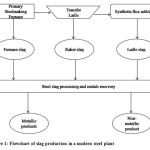 |
|
Physical and chemical and mineralogical characteristics of LD steel slag
It has been found that the density of LD slag lies between 3.3-3.6g/cm.3 Due to its high Fe content, steel slag looks in appearance a loose collection, and appears hard and wear resistant. The grindability index of steel slag is 0.7, in contrast with the value of 0.96 and 1.0 for blast furnae slag and standard sand respectively (Hou et al., 2010). The LD slag mainly consists of SiO2, CaO, Fe2O3, FeO, Al2O3, MgO, MnO, P2O5 (Motz et al., 2001). The main mineral phases contained in steel slag are dicalcium silicate (C2S), tricalcium silicate (C3S), RO phase (CaO-FeO-MnO-MgO solid solution), tetra-calcium aluminoferrite (C4AF), olivine, merwinite and free-CaO (Kourounis et al., 2007; Goldring et al., 1997). The reuse and recycle of the steel slag is closely related to its chemical and physical characteristics. Many studies have been carried out for chemical and mineralogical characteristics of LD slag. The chemical characterisation of LD slags was determined by ICP-AES and C-H-N-S analyser. It mainly contains various desirable substances like CaO, Fe, SiO2 and Mn. The lime content measurement was carried out by using three analytical techniques namely Leduc test, thermo gravimetric analysis and Bernard calcinatory analyses (Waligora et al., 2010). Table 1 summarizes the chemical composition of LD slag (Singh et al., 2013; Das et al., 2007; Waligora et al., 2010), Table 2 depicts the chemical composition and major phases of typical LD slag generated at integrated steel plant in India (Goldring et al., 1997) and Table 3 depicts the characteristics and applications of steel slag (Yi et al., 2012).
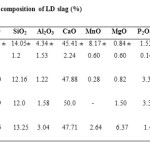 |
|
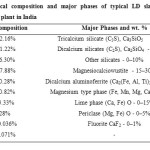 |
|
The phosphorus content in LD slag is too high to be reused in iron making and one-hundredth percent of phosphorus go to the metal phase. The major phases present in LD slag in other parts of world are also studied, that contain some reactive mineral phase such as 2CaO.SiO2, 3CaO.SiO2, free CaO and MgO (Goldring and Jukes, 1997). Main mineral phases were identified by using X-ray diffraction (XRD) and the microscopic studies like scanning electron microscope (SEM), electron probe micro analysis (EPMA) and energy dispersive x-ray spectroscopy (EDS). The EPMA study of LD slag sample was carried out to know the association of phosphorus in LD slag and there was some variation found with respect to Fe, Ca, Al and Mn content. Most of the analysis relates to very low MgO content and hence not reflected in EPMA study. However, it is evident that P content in the slag is more attached to the calcium phase than to the iron phase (Das et al., 2007).
Research progress of LD steel slag utilization
Steel LD slag is a secondary resource of raw material in metallurgical plant. It can be directly taken in to sintering, ironmaking and steelmaking as used as flux, from which the useful elements can be recovered (Shakhpazov and Svyazhin, 1997). The advantage is that the premelted flux is more easily remelted than the raw flux. On the other hand, steel slag can be used as construction material, pavement material and engineering material. The remainder is either stored or used for landfilling. Steel slags have been utilized successfully as a construction material, due to their good technical properties. Through proper quality control, the steel slags aggregates can reach a stronger bearing capacity; permanently stable if the requirements for the volume stability have been fulfilled, and do not influence the environment by leaching (Motz and Geiseler, 2001). The possible problems associated with utilization of steelmaking slags are volume stability and leaching of heavy metals such as Cr and V. The high free CaO leads to hydration and causes cracking in structures (Reeves and Lu, 2000). Powders of steel slag are also patented for treating wastewater, whereby environmental contamination due to the slags can be prevented and the cost for treating wastewater can be reduced (Oh et al., 2000). In general, slag compositions determine the application of the slags. Higher free lime and magnesia are required in fertilizer production by hydration. In order to produce dense aggregates suitable for road and waterway construction and concrete structures, it is necessary to avoid free lime and magnesia formation in the slag.
LD steel slag for reclamation of acidic lands
Steel slag for reclamation of acidic mine land is an excellent use for this material. Application rates to neutralize total potential acidity of mine land are high and reapplication of lime may not be technically or economically feasible. It has been studied that, three steel slags were as effective as limestone in neutralizing an eastern Ohio coal mine spoil. These spoils are extremely acidic pH and with toxic levels of available Al. There was no seed germination on the unlimed control plots in his study. Germination was successful in all treatments with limestone and slag. Application to acidic landfill cover a unique application for materials like steel slag is remediation of acidic landfill final cover. Along the east coast of the U.S., soils used for final vegetative cover on landfills have failed to maintain plant cover because of rapidly falling pH values. The drop in pH is due to the oxidation of sulfides in these coastal soils with the production of sulfuric acid. The rates of liming required are high and the use of limestone may not be economically feasible (Munn, 1998).
LD steel slag for soil stabilization and soil conditioner
Steel LD slag has been used as a liming agent for pasture in Northern Spain. Use of LD slag has been shown to increase the soil pH. Experiments have found that application of LD increased the soil pH linearly. The soil pH increased from 5.3 to 6.4 with the use of 7500Kg of slag/hectare, the second year response being higher i.e. 41% increase in soil pH with 3000Kg slag/hectare (Pinto et al., 1995). In soil conditioning slags are efficient in soil neutralisation. In addition, the siliceous liming materials improve soil structure and reduce fungal infections. Blast furnace slag can be used also in agriculture because of its high sorption capacity of phosphorus, which remains into the available form for the plants. Negative effects, resulting from steel slags use, could derive from their heavy metal concentrations, but such metals tend to bound to the slag matrix and thus they are not available for plants. All these factors contribute to underline positive effects of using slag as liming materials that lead to better yield of the crops, soil protection and reduction of natural resources consumption (Hiltunen and Hiltunen, 2004). Business Line dated Tuesday, May 28, 2002 (The Hindu Group) had reported NILANCHAL Refractories, a Tata group company manufacturing a soil conditioner-Growell. Growell is essentially enriched slag used as a soil conditioner or liming agent to acidic soils. Growell has been made by using the TISCO basic slag and it contains calcium, phosphates and other elements. The product has been certified by the Union Ministry of Agriculture and the Fertilizer Association of India. It has been noted that application of Growell in acidic soil increases the yield by 25% and above, According to the results LD slag appears to be a useful liming material for correcting the acidic condition of soil. This is in natural range and show a positive effect on mustard and wheat seedling growth. Thus this can be used as a rural biotechnology for better plant growth (Pradhan et al., 2003). Government of India, Ministry of Finance (Circular No 553/49/2000-CX New Delhi, the 18th October, 2000) has notified that LD slag can be used as soil conditioner after its crushing, washing and adding with rock phosphates etc. LD slag contains 29% calcium in form of CaO. Slag is principally a lime based material that absorbs the oxides and trace elements arising from refining of iron. LD slag also contains phosphorous in the form of P2O5. So, LD slag has a limiting to ground lime stone and is used regularly to regulate the need of liming on acidic soil. Many field trials and experiments have shown significant improvement in crop yield and pasture quality.
Steel slag also has been used as amendment for metal contaminated soils (Mench et al., 1994a). The use and environmental assessment of LD slag is more recent (Proctor et al., 2002; Gahan et al., 2009; Yilmaz et al., 2010). P-spiked LD slag was used as a soil additive to improve physico-chemical soil properties and in situ stabilization of Cu and other trace metals in a sandy Cu-contaminated soil (630 mg kg−1 soil). The result found that soil pH increases with increase in incorporation rate of LD slag. P-spiked LD slag incorporation into polluted soil allows the bean growth, foliar Ca concentration, but also to reduce foliar Cu concentration below its upper critical value avoiding an excessive soil EC and Zn deficiency (Negim et al., 2012).
LD steel slag as fertilizer in agriculture
Steel LD slag can also be used in fertilizers for agricultural applications (Das et al., 2007). The efforts have been made in Tata steel that LD slag after grinding to 300 mesh, can be used as a soil conditioner in paddy field, tea gardens etc (Basu et al., 2002). Nippon KokanKk Corporation (NKK) in Japan has developed a process to produce eco-friendly slow release potassium silicate fertilizer from the slag which is generated during the desiliconisation process of hot metal at steel mill. Using of slag’s ingredient is the basic idea of NKK. In this process potassium carbonate pellets are added to molten slag, containing silicon dioxide as main ingredient in hot metal ladle and melted uniformly at 1673K. The molten mixture is collected from ladle, cooled and pulverized in to granular fertilizer. The produced fertilizer which is brackish gray in colour and comprises of vitric potassium silicate as its main ingradient and exhibits slower release effects than conventional quick acting chemical fertilizer such as potassium chloride, potassium sulphate and urea ( NKK 2000). Many studies have been done for production of fertilizes from LD slag, semi-calcined dolomite and ammonium sulfate and their agricultural applications for agro-forestry, pasture farming. The influence of these materials on chemical composition of soil and grass to potential economic benefits of applying this new fertilizer to the soil were evaluated (Lopez Gomez et al., 1999). According to soil type and agricultural use by adding a concentration of LD slag between 1.5 and 5.0t/ha, it is possible to achieve increase in soil pH and improve the soil quality and also productivity. The experimental works were carried out using pulverized LD slag for growing different vegetables and crops like tomato, potato, onion, spinach and wheat in acidic soil (Maslehuddin et al., 2003). Steel slag contains fertilizer components CaO, SiO2, and MgO. In addition to these three components, it also contains components such as FeO, MnO, and P2O5, so it has been used for a broad range of agricultural purposes. Its alkaline property remedies soil acidity (Makelaa et al., 2012). In developed countries such as Germany, USA, France and Japan, converter slag is used to produce siliceous fertilizer, phosphorus fertilizer and micronutrient fertilizer (Wu et al., 2005).
Environmental concerns about the slags use in agriculture and for land reclamation
Soluble salts
Agricultural limestone CaCO3or CaMg(CO3)2 has low water solubility and only dissolves by acid attack thus, build up of soluble salts with these materials is not a concern. Steel slag will have a higher soluble salt content than limestone because of the content of CaO and MgO, which react with water to form Ca(OH)2 and Mg(OH)2. These hydroxides have water solubilities of 1.20 g/L and 0.009 g/L, respectively, compared to 0.014 g/L for CaCO3 and 0.013 g/L for MgCO3 (National Lime Association, 1990). This increase in soluble salt should be negligible in application rate of representative agronomic limes, particularly in humid regions and with well drained soils. It has been reported that the soluble salt contents of fine and coarse steel slag of 3.68 and 2.55 decisiemens per meter (dS/m) respectively. Plants can tolerate up to 4 dS/m, so soluble salts should not be an issue with agricultural applications. On reclamation sites, with higher application rates and more concentrated near the surface, soluble salts should be tested (Beck and Daniels, 2008).
Trace elements
Heavy metals are broadly distributed in the Earth’s crust and some of their chemical forms can be a potential risk to biosphere, in particular to the water life, because of their solubility. Their bioavailability depends on the plants ability to uptake them from soil and water, due to the secretion by plants roots of chelators compounds; furthermore many heavy metals are transported by sulphur ligands, such as glutathione, and organic acids. Moreover some heavy metals are insoluble and they often interactwith soil particles, and therefore they are not available to plants (Babula et al., 2008). Steel slag will contain various concentrations of trace elements, depending on the type of steel produced and on the steel process used (Munn, 1998). It has been reported that the trace element concentrations for three steel slags (Table 4).
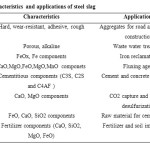 |
|
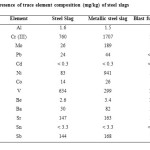 |
|
At neutral soil pHs it would be expected from liming with steel slag, solubilities and bioavailabilities of the cationic metals like Al, Cr (III), Pb, Cd, Ni, Co, Be, Ba, and Sr will be low (Munn, 1998). Also from other study it has been reported that the fine and coarse steel slags with 5169 and 4519 mg/kg of total Cr (III). Toxicity characteristic leaching procedure (TCLP) leachate concentrations for Cr (III) were 0.004 and < 0.003 for the fine and coarse slags, respectively, indicating very low solubility of this metal. There were small but non-environmentally important increases in extractable Cr (III) in soils amended with up to 10 tons/acre of slag. The oxyanions trace elements (Mo, V, Sn, and Sb) would be expected to be slightly more soluble and bioavailable at near neutral pH than the cationic metals (Beck and Daniels, 2008). Chromium (Cr) is used in different industrial field of applications such as steel industry, wood preservatives, electroplating, metal finishing, leather tanning, textiles and chemical manufacture and it is a frequent contaminant of both surface groundwaters. In oxidizing conditions is highly soluble and forms Cr(VI) anions, such as chromates CrO42-or dichromates Cr2O72-. Under reducing conditions, through a process involving a chemical reduction and a precipitation, Cr(VI) converts to Cr(III) that is insoluble. Both forms are stable in the environment. The roots plants can absorb both forms Cr3+and CrO42-, but, according to some date, the Cr(III) forms stable compounds (e.g. hydroxides, oxides and sulphates). Therefore it is less soluble and, consequently, less bioavailable (Babula et al., 2008).
Over liming
The crops have a certain soil pH in which the nutrient availability is maximized. Over liming can result in lowered plant availability of macronutrients like P and micronutrients like Fe, Cu and Zn. Due to the high reactivity of CaO and MgO in steel slag and the high equilibrium pH i.e. 12.5 of Ca(OH)2. Thus, there is a greater risk of over liming with slag than with limestone, which has an equilibrium pH of 8.25 and is much less reactive than Ca(OH)2. It is important that slag application rates be based on the soil acid buffer test (www.nationalslag.org).
Conclusions
Now days, the steel industry is committed to increasing the way for recycling slags generated during the steel production. Since their use as landfill material has almost reached its limit, the pressure for saving natural resources and energy has led steel industry along with other important technological challenges, to improve and increase the recycling of this by-product. Steel LD slag has been successfully used as a substitute for limestone to neutralize soil acidity in agricultural soils for many years, and research has shown slag use to be comparable to or superior to limestone in some cases. In addition, to its liming benefits, slag contains plant nutrients that can enhance plant growth and contains Si which has been shown to increase yields of grass crops, such as rice and sugar cane and Si also helps crops defend against crop diseases. As a coproduct of an industrial process, steel slag offers considerable cost advantages over commercial limestone. There has been significant volatility in the cost of agricultural limestone in recent years, attributable in part to energy costs of production. Cultivators have deferred use of limestone to cover the rising costs of fertilizer, even at the risk of lower yields. Growers are increasingly looking to coproduct liming materials like steel slag. Hence, many studies have been particularly focused on the behavior and immobilization in soil of the main heavy metals contained in steel converter slag in order to achieve a more effective and sustainable use of steel slags in agriculture and thus improves its recycling.
Acknowledgment
The authors are thankful to Indian School of Mines, Dhanbad, India for their valuable support and encouragement in the successful accomplishment of this paper. The author (Sasmita Chand) is also thankful to the Ministry of Human Resource Development (MHRD), Government of India and Indian School of Mines, Dhanbad for providing the Junior Research Fellowship (JRF).
References
- A guide for the use of steel slag in agriculture and for reclamation of acidic lands, http://www.nationalslag.org/sites/nationalslag/files/ag_guide909.pdf.
- Alexandre, J., and Boudonnet, J.Y., Les laitiers d'aciérie LD et leurs utilisations routières. Laitier sidérurgiques., 75: 57–62 (1993)
- Babula, P., Adam, V., Opatrilova, R., Zehnalek, J., Havel, L., and Kizek, R.V., Uncommon heavy metals, metalloids and their plant toxicity: a review. Environmental Chemistry Letters., 6: 189-213 (2008)
- Basu, G. S., Sharma, R. P., and Dhilon, A.S., Solid waste management in steel plants challenges and opportunities. Tata Search., 39-42 (2002)
- Basu, P., Alternative ironmaking technologies: an environmental impact analysis. In: Proceeding of Environment and Waste Management, NML, Jamshedpur, India, pp: 194-202 (2002)
- Beck, M., and Daniels, W. L., Tube City IMS, LLC steel slag characterization study. Department of Crop and Soil Environmental Sciences. Virginia Tech University, Blacksburg, VA. (Unpublished report). (2008)
- Das, B., Prakash, S., Reddy, P. S. R., and Mishra, V. N., An overview of utilization of slag and sludge from steel industries. Resour. Conserv. Recycl., 50: 40-57 (2007)
- Gahan, C.S., Cunha, M. L. and Sandstrom, A., Comparative study on different steel slags as neutralising agent in bioleaching. , 95: 190–197 (2009)
- Gao, J. T., Li, S. Q., Zhang, Y. T., Zhang, Y.L., Chen, P. Y., and Shen, P., Process of Re-Resourcing of Converter Slag. J Iron Steel Res Int., 18: 32-9 (2011)
- Goldring, D. C., and Juckes, L. M., Petrology and stability of LD slag. Iron Making Steel Making., 24: 447–56 (1997)
- Hiltunen, R., and Hiltunen, A., Environmental aspects of the utilization of steel industry slags, Proceedings of VII Intenational Conference on Molten Slags, Fluxes and Salts. The South African Institute of Mining and Metallurgy, ISBN 1–919783–58–X. (2004)
- Hou, G. H., Wang, Z. H., and Zhu, X., Difference of grindablity and cementions performance activity among minerals in steel slag. J Yancheng Technol I (in Chinese)., 23: 1-4 (2010)
- Kourounis, S., Tsivilis, S., Tsakiridis, P.E. Papadimitriou, G. D., and Tsibouki, Z., Properties and hydration of blended cements with steelmaking slag. Cement Concrete Res., 37: 815-822 (2007)
- Lopez Gomez, F. A., Aldecoa, R., Fernandez Prieto, Rodrigues, M. A., and Julia, M., Preparation of NPK fertilisers from ferrous-metallurgy. Simoes C Eur Commun [Rep]., 18616: 1–57 (1999)
- Makelaa, M., Watkins, G., Poykio, R., Nurmesniemiet, H., and Dahl, O., Utilization of steel, pulp and paper industry solid residues in forest soil amendment: relevant physicochemical properties and heavy metal availability. J Hazard Mater., 207-208: 21-27 (2012)
- Maslehuddin, M., Alfarabi, A. M., Sharif, M., Shameen, M., Ibrahim, M., and Barry, M. S., Comparison of properties of steel slag and crushed limestone aggregate concretes. Build. Mater., 17: 105–12 (2003)
- Mench, M., Didier, V., Löffler, M., Gomez, A., and Masson, P., A mimicked in-situ remediation study of metal-contaminated soils with emphasis on cadmium and lead. J Environ Qual., 23: 58–63 (1994a)
- Meng, H. D., and Liu, L., Stability processing technology and application prospect of steel slag. Steelmaking (in Chinese)., 25: 74-8 (2000)
- Motz, H., and Geiseler, J., Products of steel slags an opportunity to save natural resources. Waste Manage., 21: 285-293 (2001)
- Munn, D. A., Comparison of steel industry slags with traditional ag limestone on corn and turf crops. The Ohio State University Agricultural Technical Institute, Wooster, OH. (Unpublished report). (1998)
- National Lime Association. Lime: handling, application and storage. Arlington, VA 22201. (1990)
- Negim, O., Mench, M.,Bes, C., Motelica-Heino, M., Amin, F., Huneau, F., and Le Coustumer, , In situ stabilisation of trace metals in a copper-contaminated soil using P-spiked Linz–Donawitz slag. Environ Sci Pollut R., 19: 847–857 (2012)
- Nippon KokanKk Corporation (NKK) promoting effective utilisation of steel making slag. NKK Monthly, December, 25 (2000)
- Oh, Ok, Soo, Oh, Sang, and Yoon. Patent number WO0185618, Patent application data: Number KR0000701. Date: 30 Jun, (2000)
- Pinto, M., Rodrigvez M., and Besga, G., Effects of Linz-Donawitz(LD) slag as soil properties and pasture production in the Basque country(Northern Spain). New Zealand Journal of Agricultural Research., 38: 143-155 (1995)
- Pradhan, , Kar, R. N.,Sukla, L. B., Das, B., and Mishra, V. N., Use of steel plant waste (LD Slag) as soil conditioner. In: proceeding of international seminar on Downsizing Technology for Rural Development., pp: 224-229 (2003)
- Proctor, D. M., Shay, E. C., Fehling, K. A. and Finley, B. L., Assessment of human health and ecological risks posed by the uses of steel industry slags in the environment. Hum Ecol Risk Assess., 8: 681–711 (2002)
- Ramachandran, V., The treatment and minimization of waste. J. Met., February, pp: 50–51 (1995)
- Reeves, B. J., and Lu, W. K., High temperature modification of steelmaking slags by the addition of fayalite slag to react a volumetrically stable aggregate. Proceedings of the Sixth International Conference on Molten Slags, Fluxes and Salts., Stockholm, Sweden-Helsinki, Finland, 12–17 June, CD Rom-paper 210 (2000)
- Shakhpazov, E. H., and Svyazhin, A. G. Slag recycling in ferrous metallurgy. EOSC’97: 2nd European Oxygen Steelmaking Congress., Taranto, Italy, 13–15 Oct, pp: 499–506 (1997)
- Shen, D. H., Wu, C. M., and Du, J. C., Laboratory investigation of basic oxygen furnace slag for substitution of aggregate in porous asphalt mixture. Constr Build Mater., 23: 453–61 (2009)
- Singh, R., Gorai, A. K. and Segaran, R. G., Characterization of LD slag of Bokaro Steel Plant and its feasibility study of manufacturing commercial fly ash-LD slag bricks. Env Techno Manag., 16: 129-145 (2013)
- Takano, Cyro et al., Recycling of Solid Waste From Integrated Steel Plant: A Sustainable Alternative. Materials Transactions., 42: 2560-2570 (2001)
- Umadevi, T., Rao, S. P., Roy, Pankaj., Mohapatra, P.C., Prabhu, M., and Ranjan, M., Influence of LD slag on iron ore sinter properties and productivity. In: 6th international seminar on mineral processing technology, NML, Jamshedpur, pp: 747-757 (2010)
- Waligora, J., Bulteel, D., Degrugilliers, P., Damidot, D., Potdevin, J. L., and Measson, M., Chemical and mineralogical characterisations of LD converter steel slag: A multi-analytical techniques approach. Mater Charact., 61: 39-48 (2010)
- Wu, S., Xue, Y., Ye, Q., and Chen, Y., Utilization of steel slag as aggregates for stone mastic asphalt (SMA) mixtures. Build Environ., 42: 2580–5 (2007)
- Wu, Z. H., Zou, Z. S. and Wang, C. Z., Application of converter slags in agriculture. Multipurpose Util Min Resour (in Chinese)., 6: 25-8 (2005)
- Yadav, U. S., Das, B. K., Kumar, A., and Sandhu, H. S., Solid waste recycling through sinter status at Tata Steel. In: Proceeding of Environment and Waste Management, NML, Jamshedpur, India, pp: 81-94 (2002)
- Yi, Huang., Xu, Guoping., Cheng, Huigao., Wang, Junshi., Wan, Yinfeng., and Chen, Hui., An overview of utilization of steel slag. In: 7th International Conference on Waste Management and Technology. Procedia Environmental Sciences., 16: 791 – 801 (2012)
- Yilmaz, D., Lassabatere, L., Angulo-Jaramillo, R., Deneele, D., and Legret, M., Hydrodynamic characterisation of basic oxygen furnace slag through an adapted BEST method. Vadose Zone J., 9: 107–116 (2010)






